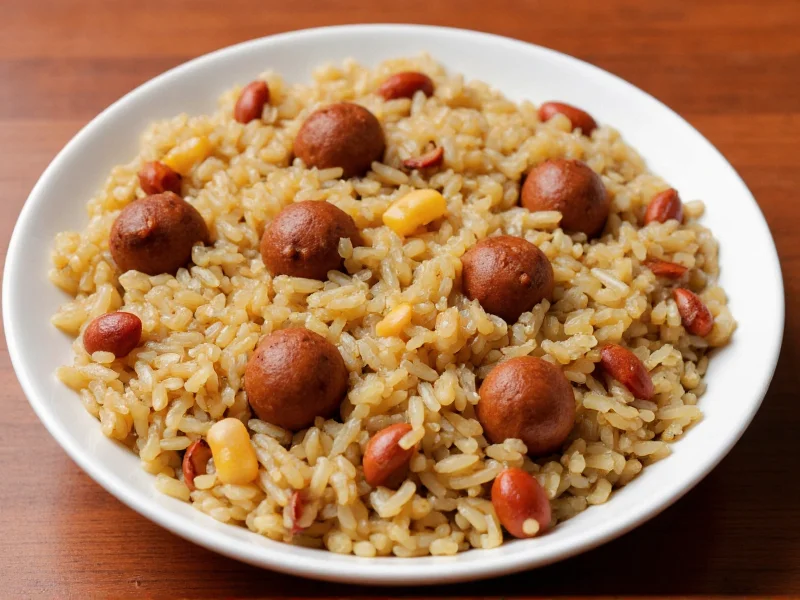Sausage rice represents one of the most universally beloved comfort food combinations, appearing in culinary traditions across the globe. This simple yet sophisticated pairing transforms basic ingredients into satisfying meals through careful technique and thoughtful ingredient selection. Whether you're preparing a quick weeknight dinner or an elaborate feast, understanding the fundamentals of sausage rice preparation ensures consistently delicious results.
The Science Behind Sausage and Rice Pairing
The magic of sausage rice lies in the complementary textures and flavor exchange between ingredients. As sausage cooks, it releases fat containing fat-soluble flavor compounds that infuse the rice during cooking. The rice, in turn, absorbs these flavors while providing a neutral canvas that balances the sausage's intensity. This symbiotic relationship creates a dish greater than the sum of its parts.
Optimal Sausage Selection for Rice Dishes
Not all sausages perform equally well in rice preparations. The ideal sausage for rice dishes maintains structural integrity during cooking while releasing sufficient flavor compounds. Consider these characteristics when selecting sausage for your rice recipe:
| Sausage Type | Best For | Preparation Tip | Flavor Profile |
|---|---|---|---|
| Chorizo (Spanish) | Paella-style dishes | Remove casing before cooking | Smoky paprika, garlic, complex spices |
| Lap Cheong | Asian fried rice | Slice thinly before stir-frying | Sweet, fermented, distinctive aroma |
| Andouille | Cajun dirty rice | Cook until rendered fat appears | Peppery, smoky, complex fermentation notes |
| Italian Sausage | One-pot meals | Brown thoroughly before adding rice | Fennel, garlic, sweet or hot pepper |
| Breakfast Sausage | Weekend brunch rice bowls | Cook separately to control grease | Sage, pepper, savory herbal notes |
Mastering the Cooking Technique
Professional chefs emphasize three critical phases in perfect sausage rice preparation. First, properly brown your sausage to develop Maillard reaction compounds that create complex flavors. Remove sausage once browned but leave the flavorful fat in the pot. Second, sauté aromatics (onion, garlic, celery) in the sausage fat to build flavor foundations. Third, toast the rice briefly before adding liquid to create a protective layer that prevents mushiness.
The liquid-to-rice ratio requires special attention when cooking with sausage. Since sausage releases additional liquid during cooking, reduce your standard rice liquid measurement by ¼ cup per cup of rice. For example, where you'd normally use 2 cups liquid for 1 cup rice, use 1¾ cups when preparing sausage rice. This adjustment prevents soggy results while ensuring complete rice cooking.
Global Sausage Rice Variations Worth Trying
Culinary traditions worldwide have developed distinctive sausage rice preparations worth exploring:
Spanish Chorizo Rice
This paella-inspired preparation features Spanish chorizo, bomba rice, saffron, and smoked paprika. The key technique involves creating socarrat—the prized caramelized crust at the bottom of the pan—by increasing heat during the final cooking minutes. Authentic versions use rabbit or chicken stock and include bell peppers and tomatoes.
Chinese Lap Cheong Fried Rice
Using sweet cured Chinese sausage, this variation requires day-old rice for optimal texture. The lap cheong's natural sweetness balances perfectly with soy sauce and sesame oil. Professional wok hei (breath of the wok) technique creates the characteristic smoky flavor, though home cooks can approximate this by using maximum heat and minimal oil.
Creole Dirty Rice
Originating in Louisiana, this version incorporates chicken livers along with andouille sausage for deep umami flavor. The "dirty" refers to the rice's appearance from finely chopped organ meats. Properly executed dirty rice features a complex spice blend including thyme, cayenne, and filé powder, with the sausage providing essential fat content for flavor development.
Troubleshooting Common Sausage Rice Problems
Even experienced cooks encounter issues with sausage rice preparation. Understanding these common problems and their solutions ensures consistent success:
- Mushy rice: Caused by excess liquid or overcooking. Solution: Reduce liquid by ¼ cup per cup of rice and check for doneness 5 minutes before recipe suggests.
- Dry, crumbly texture: Results from insufficient liquid or improper rice-to-sausage ratio. Solution: Add 2-3 tablespoons hot broth and let rest covered for 10 minutes.
- Bland flavor: Often occurs when sausage isn't properly browned. Solution: Cook sausage until deeply caramelized and deglaze pan with wine or broth to incorporate fond.
- Uneven cooking: Happens when rice isn't stirred properly. Solution: Stir once after adding liquid, then avoid stirring to prevent starch release.
Storage and Reheating Best Practices
Proper storage maintains sausage rice quality for future meals. Cool completely within 2 hours of cooking, then store in airtight containers for up to 4 days. For optimal reheating, add 1-2 tablespoons liquid per cup of rice and heat gently over medium-low heat, stirring occasionally. Microwave reheating works best with a damp paper towel covering the dish to maintain moisture. Freezing sausage rice preserves quality for up to 3 months—thaw overnight in the refrigerator before reheating.
Creating Your Signature Sausage Rice Dish
Once you've mastered the fundamentals, experiment with customizations that reflect your personal taste. Try adding roasted vegetables like bell peppers or peas during the last five minutes of cooking. Incorporate fresh herbs such as parsley or cilantro just before serving for brightness. For extra richness, finish with a pat of butter or a drizzle of high-quality olive oil. The versatility of sausage rice makes it an ideal canvas for culinary creativity while remaining reliably delicious.











 浙公网安备
33010002000092号
浙公网安备
33010002000092号 浙B2-20120091-4
浙B2-20120091-4